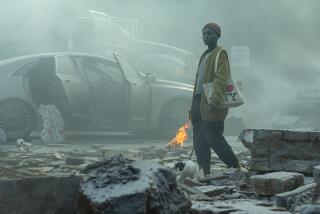‘Dawn of the Planet of the Apes’: Six things to know
“Dawn of the Planet of the Apes” opens Friday with a head of steam. Reviews for the Fox release are strong, tracking is solid and the sequel of the reboot of the movie franchise based on a novel — yes, it’s a jungle-like tangle if ever there was one — is poised to become a blockbuster in a summer season starving for them. But crafting a new tale of an emerging ape race three years after the original reboot (10 years in movie time, after a simian flu wiped out much of the human race) wasn’t easy. Here are six things to know about how the Matt Reeves movie is put together. [Warning: Plot spoilers ahead.]
Actors see, actors do. With all of the years passing since the destruction wreaked by the events of 2011’s “Rise of the Planet of the Apes,” most of the humans from that film are gone, replaced by a new batch led by scientist Jason Clarke and nurse Keri Russell. (If seeing the man who tracked down Osama bin Laden and the woman who gave us Felicity play leaders in a summer blockbuster isn’t an unexpected pleasure, I don’t know what is.) Gary Oldman, meanwhile, stars as a political leader with some dubious ambitions. On the other hand, the chimps and gorillas largely stay the same — chiefly Andy Serkis as an older and wiser Caesar, along with Terry Notary as Rocket and Karin Konoval as Maurice, the latter a decidedly Gary Gnu-like figure who has one of the movie’s most poignant scenes. The main change on this side is Toby Kebbell as the bonobo Koba; he replaces Christopher Gordon and has a much more substantive role as an ideological zealot.
Sequel switcheroo. From “The Godfather: Part II” to “Spider-Man 2” to “The Dark Knight,” the best film sequels are often handled by the same director as the original, as a filmmaker fully executes his vision (and has earned enough goodwill with the studio to get a shot at same). But there have been some notable examples of an improved sequel from a different director: Think James Cameron and “Aliens.” The same appears to be proving true here. “Cloverfield” director Reeves stepped in when “Rise of the Planet of the Apes” director Rupert Wyatt stepped aside, the former courted for some time by Fox and producers Peter Chernin and Dylan Clark. “Matt just combines the epic with the emotional,” Fox production chief Emma Watts told me. Fresh eyes and a new voice can help elevate a film, which is basically what happened here. There may be something of a mini-trend brewing, what with new helmers the Russo brothers similarly jump-starting “Captain America.”
Parallels to … the Middle East? Sure, it’s a summer movie with plenty of big action sequences. But “Apes’” main plot turn, which involves the attempted murder of an ape and a consequent decision over what level of hawkishness to strike in response, has echoes of the Palestinian-Israeli conflict, particularly as said conflict has been playing out in recent weeks. Throw in some territorial disputes (“Ape live here, human live there,” Caesar tells Oldman and Clarke in a tense standoff) and you have the makings of an allegory of the most sensitive order. “To me it’s more an anatomy of violence than a prescription for anything,” Reeves said, carefully, when asked about the parallels, without denying the comparison. Incidentally, it wouldn’t be the first time a classic sci-fi work had these overtones: Frank Herbert’s “Dune” was regarded as a parable of the Suez oil crisis.
Whiz-bang wizardry. Pyrotechnics are nothing new in summer films. But it’s one thing to make robots and superheroes fly around the screen; it’s another to make animals seem completely, unassailably human. The elaborate motion-capture technique — not to mention the ape-like movements of Serkis and his talented cast — assure there’s a level of realism among the apes of the kind seen in few effects-driven films. Even everyday movement, like a father stroking the head of his child, takes on an oddly anthropomorphic quality while more iconic images, like apes riding horses, seem almost western in their cinematic glory. In addition to Reeves, it’s all thanks to special-effects wizards Weta and the grandmasters Joe Letteri and Dan Lemmon.
The title concern. You may have looked at the title of this sequel and thought (after you thought “that is one mouthful”), “Wait, isn’t the dawn before the rise?” I mean, unless you’re a night owl. But usually people, and apes, rise after a dawn. It’s a confusing implication, made more confusing by the fact that this is a sequel to a prequel. The title may not make much more sense after you see the movie, but there is some hint of logic in the fact that this movie does tell the story of apes as they stand at the beginning of making this planet their own. Maybe in retrospect Fox should have gotten rid of the last movie’s rise, though. It was more of an early stirring.
His Franco-ness. A touching but also unintentionally comedic moment comes when Caesar returns to a house where he and Will Rodman from the first film, played by James Franco, forged their relationship. There’s a photo of the two of them and then a homemade video, which causes Caesar to tear up. Even after the simian apocalypse, Franco endures!
More to Read
Only good movies
Get the Indie Focus newsletter, Mark Olsen's weekly guide to the world of cinema.
You may occasionally receive promotional content from the Los Angeles Times.











